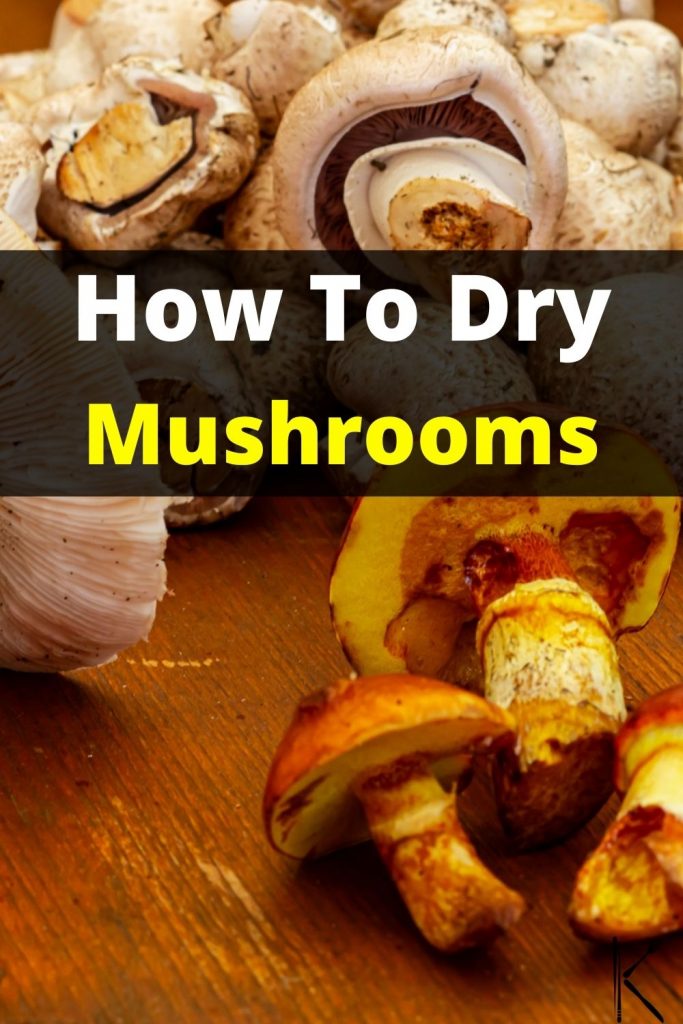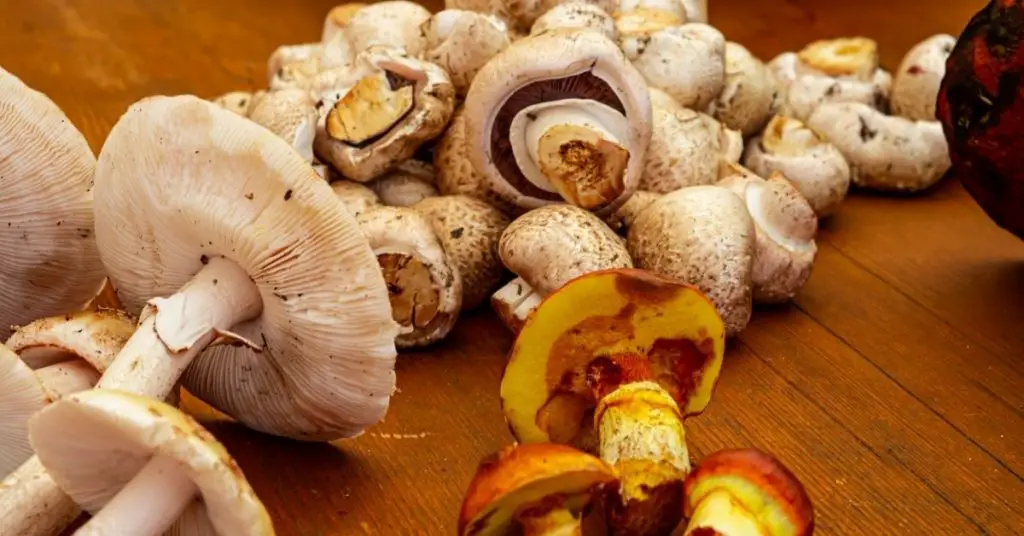Briefly, the method to dry mushrooms is oven-drying and it has seven steps: clean, slice, prepare, bake, turn, dry, and bake, cool, and store.
Delicious and versatile in cooking, mushrooms are actually classified as a fungus. Most edible mushrooms are cultivated on mushroom farms with many varieties available worldwide. Mushrooms can be added to almost any savory dish, raw or cooked. Whether it is breakfast, lunch, or dinner, these hearty vegetables add great flavor and texture.
Fresh mushrooms have high water content and don’t last long. To prolong their shelf life they can be dried and added to cooked dishes for a great depth of flavor. Here is everything you need to know about drying mushrooms at home.
Can Mushrooms Be Dried?

Yes, you can dry fresh mushrooms, and doing so significantly extends their short shelf life.
Before you dehydrate mushrooms, they should be cleaned without getting wet. Since mushrooms are porous they absorb water easily. This means that they will take longer to dry if exposed to moisture before starting the drying process. They also might not dry out completely.
Due to their naturally high moisture content, it is important to ensure the mushrooms are completely dried before storing them. Any excess moisture in the mushrooms will cause mold to grow during storage.
How to Dry Mushrooms
Step 1: Clean Mushrooms
Using a brush or dry paper towels, wipe off any dirt from the mushroom surface. If there is stubborn dirt, use a damp kitchen towel to scrub them. However, you need to wipe the same spot with a dry paper towel after cleaning to remove any moisture.
Step 2: Slice
Using a sharp knife, slice the mushrooms. The size of the slices may depend on the type of mushroom you are drying. Keep in mind that the thicker the slices, the longer it takes for them to dry. However, you don’t want the mushrooms so small that they don’t add much flavor when cooking.
Step 3: Prepare for Drying
Preheat the oven to its lowest temperature setting around 150°F (65°C).
Spread the sliced mushrooms out on a baking sheet lined with parchment paper. Arrange the mushroom slices in a single layer so that they do not overlap each other. Do not grease the baking sheet or the mushrooms as they will absorb the oil which will prevent them from drying fully.
Step 4: Bake
Place the baking tray with mushrooms in the oven to bake for an hour.
Step 5: Turn, Dry, and Bake
After an hour, take the dehydrated mushrooms out of the oven and turn them so that they can dry evenly. While doing this blot the mushrooms dry with a paper towel to remove any moisture that has risen to the surface during heating. Place the mushrooms back in the oven for another hour.
Check the mushrooms after an hour. If they are not completely dry, use a paper towel to pat them dry again and keep them in the oven until fully dehydrated. They should snap like a crisp cracker when completely dry. If they are still pliable, they need more drying time.
Step 6: Cool
Once completely dehydrated remove the mushrooms from the oven and allow them to cool. Do not start packing them until they have cooled completely.
Step 7: Store
Place the dried, cooled mushrooms in an airtight container or mason jars. Always store dried mushrooms in a cool, dark place, away from moisture and direct sunlight. Label the container with the date.
How To Use Dried Mushrooms
To reconstitute dried mushrooms soak them in stock or boiling water for 20 to 30 minutes. The soaking liquid will be full of flavor and is great to use as a base for broth, soups, or in stews. You can also freeze it to use later.
After soaking, your mushrooms will be plump and you can add them to your cooking.
Types of Mushrooms
Edible mushrooms come in various shapes and sizes. Some are very meaty and sturdy, while others are small and delicate. The following 8 types of mushrooms are commonly used in cooking, however, there are many other edible varieties:
Brown and White Mushrooms
Also known as champignon or button mushrooms, these mushrooms are either white or brown and can be eaten raw in salads, cooked into soups and sauces, used in pasta, as a pizza topping, in risotto, stir-fry, stew, crumbed and deep-fried, and even pickled.
Portobello
Portobello mushrooms are the fully mature version of white and brown mushrooms. They are large and become juicy when cooked, absorbing flavors well. They can be prepared in many different ways but are popularly pan-fried. Due to their meatiness, these mushrooms are also a popular vegan substitute for burger patties.
Oyster Mushrooms
Oyster mushrooms have large, yet delicate frills that come in a variety of soft colors. They have a mild meaty flavor and are great roasted with herbs. They can also be eaten raw, pan-fried, or added to stews and stir frys.
King Oyster Mushrooms
These mushrooms are largely used for their thick stems since they have quite a small top cap. The stems have a strong umami flavor and a meaty texture.
Shiitake
Shiitake mushrooms are best eaten cooked. Although available worldwide, they are popular in Asian cuisine. When dried, the stems are used for depth of flavor and richness in broths, stocks, soups, and sauces.
Hen of the Woods
Also known as Maitake, these are clusters of capped fan-shaped mushrooms. Native to Japan and the United States, Maitake mushrooms have a mild woody flavor and can be delicious simply pan-fried in butter.
Enoki
These little mushrooms almost look like bunches of oversized white pins with their long thin stems and pin-like top. They can be pickled, used in broth, or pan-fried bringing a great nuttiness and texture to dishes.
Chanterelle
These beautiful mushrooms have a vase shape and are popular to use on their own or in mild dishes, allowing their natural flavor to shine. They come in a variety of colors from white and yellow to pink and have a nutty, peppery flavor. They are popularly served with chicken dishes or wild mushroom soups.
FAQ
Conclusion
Mushrooms have a short shelf life and that is why drying them is a great way to prevent waste and preserve them indefinitely. When drying or dehydrating mushrooms, it is important to get the mushrooms clean using a dry method. For long-term storage, they need to be cracker dry.
After drying, let them cool completely before you arrange the mushrooms in airtight containers.
All these tips help to preserve mushrooms and assist in preventing the growth of mold during storage. To rehydrate mushrooms, simply soak them in hot liquid.
Mushrooms are incredibly versatile. Dry and enjoy!
See more: Can You Freeze Mushrooms?

*image by MarcOliver_Artworks/depositphotos









